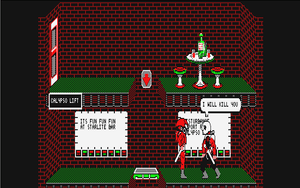Brataccas

Brataccas is a video game released in 1986 for the Amiga, Atari ST, and Macintosh,[1] and was the first game published by Psygnosis. It is a science fiction action-adventure game, with role-playing game elements. Brataccas is believed to be the remains of the much hyped vaporware project Bandersnatch, which was partially developed by Imagine Software.
Story
The player controls Kyne, a genetic engineer who has developed technology for creating supermen. The oppressive government of the day desires this research to create a breed of supersoldier, but Kyne refuses to assist. In retaliation, the government frames him for treason, claiming that he is seeking to sell his work to the underworld. At the same time, the government secretly offers a reward to anyone in the underworld who turns Kyne over to them. With both the forces of law and lawlessness aligned against him, Kyne is forced to flee Earth.[2]
During his escape, Kyne learns that evidence needed to clear his name can be found on the distant asteroid of Brataccas. Brataccas, first of the asteroids to be colonized, is a backwater mining colony with a "wild west" feel of lawlessness and corruption. Kyne has to find the evidence in order to win the game, obtaining it from the in-game characters. The manual gave no indication of who held the evidence, suggesting that everyone was equally corrupt and dangerous to talk to.
Gameplay
Brataccas displays the game world as a series of rooms that would appear on-screen as the character moved through the habitat, each one displayed from a side view (a pre-side-scroller). Most movement was horizontal, with automatic elevators to permit access to different floors. Occasionally, labeled doors in the rear wall or teleportation booths with the appearance of cylindrical shower stalls led the player to different sets of rooms. The term "rooms" is slightly inaccurate, as there were also a small number of outdoor areas displayed using the same system. In order to preserve detail on the character animations, the characters had to be fairly large, making the rooms small in relative terms. They could get quite crowded with even a few characters in them.
The player had a limited amount of interaction with the game world, generally limited to movement, picking up or dropping objects, or talking to non-player characters (NPCs). These NPCs operated under computer control and pursued their own objectives, sometimes even engaging in combat with other NPCs. All the game's characters utilized swords in combat to maintain extended battle in the small rooms, justified in-game as a measure to avoid potential loss of atmosphere to space from stray ranged weapons fire.
Interaction between characters was carried out through dialog bubbles similar to those in comic strips. The player could only respond to other statements, at which point a menu of possible responses appeared. The selections were fairly limited, and the outcomes often seemingly random. Additionally, a number of loudspeakers located in some rooms would announce events like fights breaking out. No attempt was made to "declutter" the balloons, so if more than two characters were talking the screen would often fill with them, rendering most of them unreadable.
The control system was an early example of a gesture-based interface, or as many reviews pointed out, a poor attempt at one. To move, the mouse was moved in the direction the player wanted to walk, or faster if they wanted to run. However, the inaccuracy of the system combined with lag times in the interpretation of the movements often rendered the game almost uncontrollable. One reviewer wrote, "Controlling Kyne reliably ... in a critical situation is nearly impossible."[3]
Interaction with objects was limited to picking them up or dropping them, at which point other characters might interact with them as well. For instance, one could buy information by dropping money, bags of which were scattered around the game world. One annoying gameplay problem was that if Kyne fell from one level to another, he would drop whatever he was holding. If another character was there, they would pick it up.
Critical reception
This game was originally created for the Sinclair QL, but was instead ported over to other Motorola 68000-based machines and released on the Commodore Amiga, Atari ST, and Apple Mac in 1985.
The game received mixed reviews. Audiences generally liked its sophisticated setting and story and ambitious graphics; on the Amiga and Atari ST, the game ran in 4-color, 640 × 200 resolution, a high resolution mode rarely used for games at the time. On the Atari ST, it was one of the very rare games to support the monochrome 640 × 400 high resolution which required a special monochrome monitor (model SM 124 or SM 144), and it is likely to be the only game ever which allowed to change the type of monitor during gameplay. (Disconnecting the monitor or TV-Set usually resulted in a machine reboot in order to protect the video equipment.)
However, it was criticized for the extremely difficult game controls.[3]
Cover art
The box cover art for Brataccas was made by fantasy artist Roger Dean, who would provide artwork for many Psygnosis titles. It was later used as the album cover for Uriah Heep's 2001 album Remasters: The Official Anthology.
References
- ↑ Brataccas info at Psygnosis.org
- ↑ The Story so Far - Brataccas manual's short backstory
- ↑ 3.0 3.1 Brataccas review by Michael Fleischmann, Antic Vol. 5 No. 2, June 1986. URL accessed 2006-04-17.
External links
- Brataccas at MobyGames
- brataccas.com fan site, with full text of original game manual
- youtube short video depicting scenes of the game
- Brataccas.NET another fan site, about technical aspects
- Compute! magazine 1986 review of Brataccas